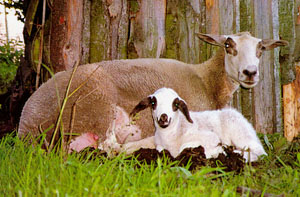Spiegel Sheep
 The Spiegel sheep comes from Prättigau, the Bündner district and the bordering regions.
It might have served as a starting breed for the purified Luzein sheep in the 17th and 18th centuries. Influences from the Austrian Spectacled sheep
in the last century are suspected, when the borders for wandering herds were yet open.
The Spiegel sheep comes from Prättigau, the Bündner district and the bordering regions.
It might have served as a starting breed for the purified Luzein sheep in the 17th and 18th centuries. Influences from the Austrian Spectacled sheep
in the last century are suspected, when the borders for wandering herds were yet open.
Representatives of Pro Specie Rara searched at great length for the last animals of this old breed and had given up hope when a farmer from the Bündner district let them know that he was keeping Spiegel sheep in his equally rare herd of Luzein sheep.
Characteristics of the Animal
The Spiegel sheep is a mid-sized sheep that stands high on its feet. It reflects entirely the old type of country sheep. The wool is more course than fine, often twisted. The head, belly and legs are often without wool. The Spiegel sheep is a peaceful, disease resistant, undemanding sheep. The hooves normally give no problems. They lamb three times in two years and mostly have multiple births. The fattening ability of the lambs is average. The head is long and narrow, with half-hanging, medium long ears. The name comes from the fleeceless smooth forehead which like a mirror is supposed to glisten. Very distinguished is the dark eye spot and the corresponding dark point of the ear. Although earlier Spiegel sheep were bred without dark spectacles, this is seen now as a characteristic of the breed. The older the animals become, the more this marking fades away. Well marked animals are as lambs spotted on the whole body; after the first shearing the wool remains white even over the dark spots, another astonishing feature of this breed.
Wither Height: Ewes 62-72 cm. Rams 65-75 cm (1 kg = 2.2046 lbs)
Weight: Ewes 55-72 kg. Rams 70-90 kg, max 120 kg
References
Endangered Domestic Animal Breeds 1995, Pro Specie Rara, Engelgasse 12a, CH-9000 St. Gallen, Switzerland, Telefon: 071/222 74 20, Fax: 071/223 74 01. German Translation provided by John te Velde, Associate Professor of German, Oklahoma State University
